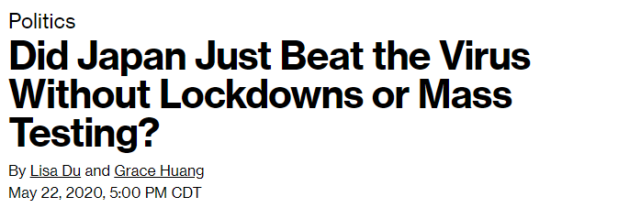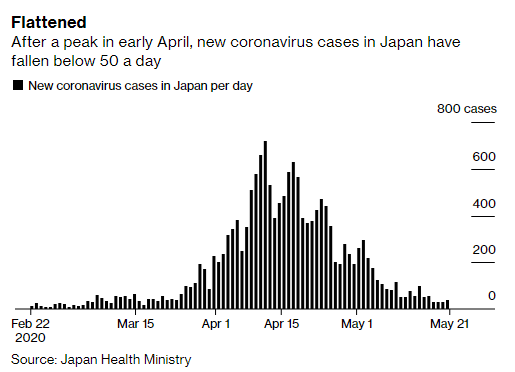Yes.
Yes, they did.
Now, let’s see how many paragraphs can be written about this, while entirely avoiding the question of whether this means that this virus, originally described as cataclysmic, is actually as benign as the CDC is reporting that it is.
Japan’s state of emergency is nearing its end with new cases of the coronavirus dwindling to mere dozens. It got there despite largely ignoring the default playbook.
No restrictions were placed on residents’ movements, and businesses from restaurants to hairdressers stayed open. No high-tech apps that tracked people’s movements were deployed. The country doesn’t have a center for disease control. And even as nations were exhorted to “test, test, test,” Japan has tested just 0.2% of its population — one of the lowest rates among developed countries.
Yet the curve has been flattened, with deaths well below 1,000, by far the fewest among the Group of Seven developed nations. In Tokyo, its dense center, cases have dropped to single digits on most days. While the possibility of a more severe second wave of infection is ever-present, Japan has entered and is set to leave its emergency in just weeks, with the status already lifted for most of the country and likely to exit completely as early as Monday.
Analyzing just how Japan defied the odds and contained the virus while disregarding the playbook used by other successful countries has become a national conversation. Only one thing is agreed upon: that there was no silver bullet, no one factor that made the difference.
“Just by looking at death numbers, you can say Japan was successful,” said Mikihito Tanaka, a professor at Waseda University specializing in science communication, and a member of a public advisory group of experts on the virus. “But even experts don’t know the reason.”
Well, folks, there you have it – it’s a mystery.
I guess it’s just a virus that only affects Western capitalist democracies.
A politics-specific bio-weapon, if you will.
One widely shared list assembled 43 possible reasons cited in media reports, ranging from a culture of mask-wearing and a famously low obesity rate to the relatively early decision to close schools. Among the more fanciful suggestions include a claim Japanese speakers emit fewer potentially virus-laden droplets when talking compared to other languages.
Contact Tracing
Experts consulted by Bloomberg News also suggested a myriad of factors that contributed to the outcome, and none could point to a singular policy package that could be replicated in other countries.
Nonetheless, these measures still offer long-term lessons for countries in the middle of pandemic that may yet last for years.
An early grassroots response to rising infections was crucial. While the central government has been criticized for its slow policy steps, experts praise the role of Japan’s contact tracers, which swung into action after the first infections were found in January. The fast response was enabled by one of Japan’s inbuilt advantages — its public health centers, which in 2018 employed more than half of 50,000 public health nurses who are experienced in infection tracing. In normal times, these nurses would be tracking down more common infections such as influenza and tuberculosis.
“It’s very analog — it’s not an app-based system like Singapore,” said Kazuto Suzuki, a professor of public policy at Hokkaido University who has written about Japan’s response. “But nevertheless, it has been very useful.”
While countries such as the U.S. and the U.K. are just beginning to hire and train contact tracers as they attempt to reopen their economies, Japan has been tracking the movement of the disease since the first handful of cases were found.
…
The early response was also boosted by an unlikely happening. Japan’s battle with the virus first came to mainstream international attention with its much-criticized response to the Diamond Princess cruise ship in February that led to hundreds of infections. Still, the experience of the ship is credited with providing Japanese experts with invaluable data early in the crisis on how the virus spread, as well as catapulting it into the public consciousness.
Other countries still saw the virus as someone else’s problem, said Tanaka. But in Japan, the international scrutiny over the infections onboard and the pace at which the virus raced throughout the ship raised awareness and recognition that the same can happen across the country, he said. “For Japan, it was like having a burning car right outside your house.”
Yes – I’m sure it was all the public awareness.
Certainly, the non-stop media doom reports on this flu, despite launching the impressionable masses into a toilet-paper buying hysteria, have not yet created enough awareness as these Japanese had, because of that one cruise ship.
I suppose it does help that they are generally healthy and wear masks during flu season, and maybe we should consider doing that, since that would not collapse society.
There is probably more evidence for this approach than for shutting everything down, which has destroyed people’s lives and does not even stop everyone from getting infected anyway.
But I am not an expert, and I know the reason, just from reading the experts.
It’s just the flu.
 Daily Stormer The Most Censored Publication in History
Daily Stormer The Most Censored Publication in History





